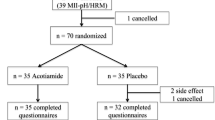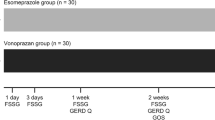Abstract
Objective
To compare the effect of esomeprazole 40 mg with lansoprazole 30 mg, omeprazole 20 mg, pantoprazole 40 mg and rabeprazole 20 mg on intragastric pH during single and repeated dosing in four separate studies in patients with symptoms of gastro-oesophageal reflux disorder (GERD).
Methods
In four randomised crossover studies, patients with symptoms of GERD received once-daily treatment with esomeprazole 40 mg or lansoprazole 30 mg (study A), omeprazole 20 mg (study B), pantoprazole 40 mg (study C) and rabeprazole 20 mg (study D) for 5 days. Continuous 24-h intragastric pH recording was performed on days 1 (except study B) and 5. Percentage of time over 24 h with intragastric pH greater than 4, 24-h median pH and the proportion of patients with pH greater than 4 for greater than or equal to 12 h and 16 h during the 24-h recording periods were investigated.
Results
In all four studies, esomeprazole 40 mg OD maintained intragastric pH greater than 4 for a significantly higher mean percentage of the 24-h period compared with all other proton pump inhibitors (PPIs) on days 1 (esomeprazole 40.6% versus lansoprazole 33.4%, P=0.0182; esomeprazole 50.3% versus pantoprazole 29.1%, P<0.001; esomeprazole 41.0% versus rabeprazole 29.4%, P=0.002) and 5 (esomeprazole 57.7% versus lansoprazole 44.5%, P<0.0001; esomeprazole 69.8% versus omeprazole 43.7%, P<0.0001; esomeprazole 67.0% versus pantoprazole 44.8%, P<0.001; esomeprazole 59.4% versus rabeprazole 44.5%, P<0.0001). Higher 24-h median pH and a higher proportion of patients with intragastric pH greater than 4 for greater than or equal to 12 h and 16 h were reported with esomeprazole 40 mg OD than with all the other PPIs in each study.
Conclusion
Esomeprazole 40 mg provides greater acid control in more patients and maintains intragastric pH greater than 4 for a longer period than lansoprazole 30 mg, omeprazole 20 mg, pantoprazole 40 mg and rabeprazole 20 mg in patients with symptoms of GERD.




Similar content being viewed by others
References
Bell NJ, Burget D, Howden CW et al (1992) Appropriate acid suppression for the management of gastro-oesophageal reflux disease. Digestion 51[Suppl 1]:59–67
Joelsson B, Johnsson F (1989) Heartburn—the acid test. Gut 30:1523–1525
Johnson LF, DeMeester TR (1986) Development of the 24-hour intraesophageal pH monitoring composite scoring system. J Clin Gastroenterol 8[Suppl 1]:52–58
Hunt RH (1999) Importance of pH control in the management of GERD. Arch Intern Med 159:649–657
Chiba N (1997) Proton pump inhibitors in acute healing and maintenance of erosive or worse esophagitis: a systematic overview. Can J Gastroenterol 11[Suppl B]:66B–73B
Chiba N, De Gara CJ, Wilkinson JM et al (1997) Speed of healing and symptom relief in grade II to IV gastroesophageal reflux disease: a meta-analysis. Gastroenterology 112:1798–1810
Dent J, Brun J, Fendrick AM et al (1999) An evidence-based appraisal of reflux disease management—the Genval workshop report. Gut 44[Suppl 2]:S1–S16
DeVault KR, Castell DO, The Practice Parameters Committee of the American College of Gastroenterology (1999) Updated guidelines for the diagnosis and treatment of gastroenterol reflux disease. Am J Gastroenterol 94: 1434–1442
Hassan-Alin M, Andersson T, Bredberg E et al (2000) Pharmacokinetics of esomeprazole after oral and intravenous administration of single and repeated doses to healthy subjects. Eur J Clin Pharmacol 56:665–670
Lind T, Rydberg L, Kyleback A et al (2000) Esomeprazole provides improved acid control vs. omeprazole in patients with symptoms of gastro-oesophageal reflux disease. Aliment Pharmacol Ther 14:861–867
Röhss K, Hasselgren G, Hedenstrom H et al (2002) Effect of esomeprazole 40 mg vs omeprazole 40 mg on 24-hour intragastric pH in patients with symptoms of gastroesophageal reflux disease. Dig Dis Sci 47:954–958
Wilder-Smith C, Röhss K, Claar-Nilsson C et al (2002) Esomeprazole 40 mg provides faster and more effective acid control than lansoprazole 30 mg in patients with symptoms of gastroesophageal reflux disease (GERD). Gastroenterology 122(4)[Suppl 1]:A200
Wilder-Smith C, Röhss K, Lundin C et al (2000) Esomeprazole 40 mg provides more effective acid control than pantoprazole 40 mg. Gastroenterology 118:A22–A23
Röhss K, Wilder Smith C, Claar Nilsson C et al (2001) Esomeprazole 40 mg provides faster and more effective acid control than rabeprazole 20 mg in patients with symptoms of GERD. Am J Gastroenterol 96[Suppl S]:S45
Thomson ABR, Claar-Nilsson C et al (2000) Esomeprazole 40 mg provides more effective acid control than lansoprazole 30 mg during single and repeated administration. Gut 47[Suppl III]:63
Wilder-Smith C, Röhss K, Claar Nilsson C (2000) Esomeprazole 40 mg provides more effective acid control than rabeprazole 20 mg. Gut 47[Suppl 3]:A63
Wilder-Smith CH, Lind T, Lundin C et al (2003) Comparison of esomeprazole (20, 40, 80 mg) versus lansoprazole (15, 30 and 60 mg) on intragastric pH in healthy subjects. Gastroenterology 124:[4 Suppl]A44
Janczewska I, Sagar M, Sjostedt S et al (1998) Comparison of the effect of lansoprazole and omeprazole on intragastric acidity and gastroesophageal reflux in patients with gastroesophageal reflux disease. Scand J Gastroenterol 33:1239–1243
Robinson M, Maton PN, Rodriguez S et al (1997) Effects of oral rabeprazole on oesophageal and gastric pH in patients with gastro-oesophageal reflux disease. Aliment Pharmacol Ther 11:973–980
Tutuian R, Katz PO, Bochenek W et al (2002) Dose-dependent control of intragastric pH by pantoprazole, 10, 20 or 40 mg, in healthy volunteers. Aliment Pharmacol Ther 16:829–836
Bell NJ, Hunt RH (1992) Progress with proton pump inhibition. Yale J Biol Med 65:649–657
Holloway RH, Dent J, Narielvala F et al (1996) Relation between oesophageal acid exposure and healing of oesophagitis with omeprazole in patients with severe reflux oesophagitis. Gut 38:649–654
Kahrilas PJ, Falk GW, Johnson DA et al (2000) Esomeprazole improves healing and symptom resolution as compared with omeprazole in reflux oesophagitis patients: a randomized controlled trial. The Esomeprazole study investigators. Aliment Pharmacol Ther 14:1249–1258
Richter JE, Kahrilas PJ, Johanson J et al (2001) Efficacy and safety of esomeprazole compared with omeprazole in GERD patients with erosive esophagitis: a randomized controlled trial. Am J Gastroenterol 96:656–665
Castell DO, Kahrilas PJ, Richter JE et al (2002) Esomeprazole (40 mg) compared with lansoprazole (30 mg) in the treatment of erosive esophagitis (EE). Am J Gastroenterol 97:575–583
Lauritsen K, Deviere J, Bigard MA et al (2003) Esomeprazole 20 mg and lansoprazole 15 mg in maintaining healed reflux oesophagitis: metropole study results. Aliment Pharmacal Ther 17:333–341
Acknowledgements
This study was supported by a grant from AstraZeneca R&D Mölndal, Mölndal, Sweden.
Author information
Authors and Affiliations
Corresponding author
Additional information
The experiments within this paper comply with the current laws of the countries in which they were conducted.
Rights and permissions
About this article
Cite this article
Röhss, K., Lind, T. & Wilder-Smith, C. Esomeprazole 40 mg provides more effective intragastric acid control than lansoprazole 30 mg, omeprazole 20 mg, pantoprazole 40 mg and rabeprazole 20 mg in patients with gastro-oesophageal reflux symptoms. Eur J Clin Pharmacol 60, 531–539 (2004). https://doi.org/10.1007/s00228-004-0804-6
Received:
Accepted:
Published:
Issue Date:
DOI: https://doi.org/10.1007/s00228-004-0804-6




